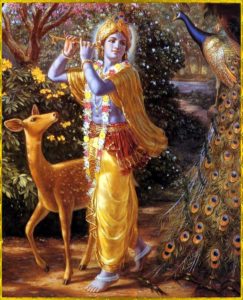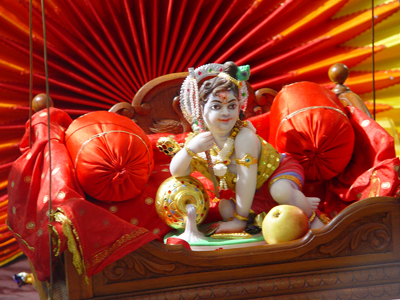There are many different holy days within the Hindu religion, all of which are associated with different gods and are celebrated with different festivities. One of the most popular of these holy days is known as Krishna Jayanti, or Janamashtami.
In order to fully understand the importance of this festival, it is helpful to have a little background knowledge of this complex religious tradition. Hinduism is among the world’s oldest religions and boasts over 900 million followers around the globe. Over 80% of the population of India regards themselves as members of the Hindu tradition. The Hindu religion teaches that there is one God, Brahman, who created and is present in everything. However, Hindus worship many other lesser deities as well, the most important of which are Brahma, Vishnu, and Shiva. Hindu’s believe that Brahman’s work on Earth is done and this triumvirate has taken over Brahman’s role of creating, maintaining and destroying the world.
Brahma and Shiva’s Role
Brahma takes on the role of the creator of the universe and Shiva takes on the role of destroyer. Vishnu preserves and protects the universe by returning to the earth in times of trouble and restoring the delicate balance between good and evil.
The Birth of Krishna
The Hindu holy day Janamashtami celebrates the birth of Krishna, the eighth incarnation of the god Vishnu. Krishna is one of the most popular gods in the Hindu tradition and is considered to be a warrior, hero, teacher, and philosopher.
Like many Hindu gods, Krishna is perceived differently among different traditions. While details may vary from one tradition to the next, some core features are shared by all, including a divine incarnation, a pastoral childhood and youth, and a life as a heroic warrior and teacher.
 Often known as the “dark one”, Krishna embodies both love and divine joy and is the destroyer of all pain and sin. Regarded as both a trickster and lover, Krishna is also the protector of sacred utterances and cows.
Often known as the “dark one”, Krishna embodies both love and divine joy and is the destroyer of all pain and sin. Regarded as both a trickster and lover, Krishna is also the protector of sacred utterances and cows.
Popular representations of Krishna include a baby, a young boy playing the flute, or a young prince providing direction and guidance.
The festival of Krishna Janamashtami takes place during the month of Sravana, eight days after Raksha Bandhan, which is another Hindu holy day. The celebration lasts for two days, the first of which is called Krishan ashtami or Gokul ashtami and the second of which is known as either Kaal ashtami or more commonly as Janam ashtami.
For two days, worshippers will not rest, but instead will dance and sing traditional Hindu songs known as bhajans. These songs are an important form of worship, used to celebrate the memory of this supreme god. It is believed that Vishnu was reincarnated as Krishna at midnight and thus it is at this hour that the Janamashtami festivities really begin. Some Hindu’s choose to fast for the first day of Janamashtami and will not eat until after the midnight celebrations, when Krishna’s favorite food, made of milk and curds is often prepared.
Worshippers also act out plays, which are based on scenes from Krishna’s early life. Images of Krishna are bathed and placed in cradles to the sound of ringing bells and the song of the conch shell (shankh). Holy mantras may also be chanted.
Because Vishnu and his incarnation Krishna are so important among the Hindu gods, Janamashtami is a very important Hindu holy day and one that is celebrated very seriously by many Hindus.






